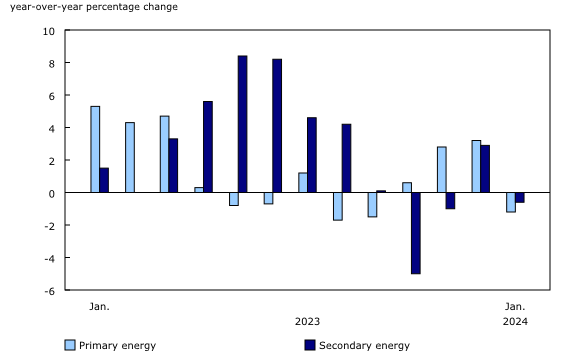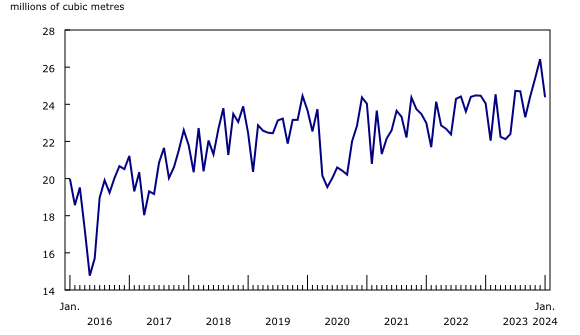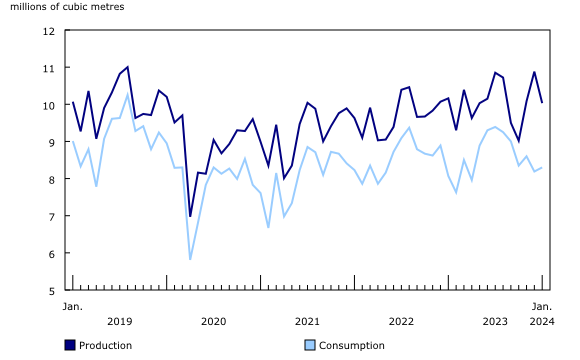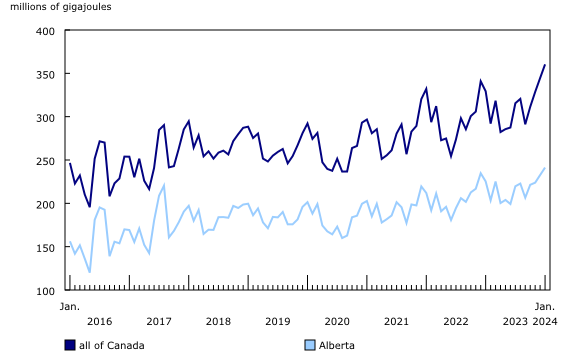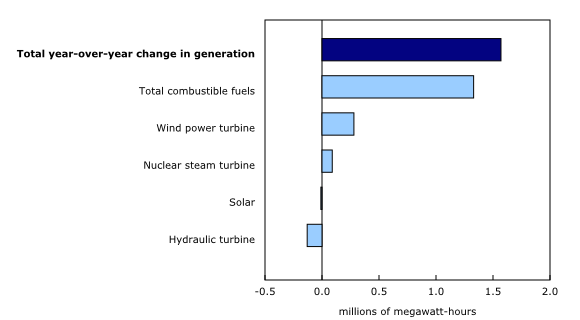Energy statistics, January 2024
Released: 2024-04-02
In January, primary energy production was down 1.2% year over year to 2.0 million terajoules, with four of the six subsectors posting declines. Similarly, secondary energy production declined 0.6% to 0.5 million terajoules, mainly due to a pull back from refined petroleum products (-2.3%).
For more information on energy in Canada, including production, consumption, international trade, and much more, please visit the Canadian Centre for Energy Information portal and follow #energynews on social media.
The following 2023 energy annual review articles are now available in StatsCAN Plus:
• Record high crude oil production largely driven by oil sands: Crude oil year in review 2023
• Record natural gas production driven by industrial deliveries: Natural gas year in review 2023
Oil sands extraction increases despite cold temperatures in western Canada
In January, production of crude oil and equivalent products rose 1.4% from the same month last year to 24.4 million cubic metres. The overall gain was driven by oil sands extraction which recorded its third consecutive monthly year-over-year increase, up 2.5% in January to 15.9 million cubic metres.
Despite the overall strength in the oil sands sector, crude oil production was impacted by extremely cold temperatures observed in January in western Canada. Production of crude bitumen fell 2.2% year over year to 9.6 million cubic metres, the first decline in production since August 2023.
Oil extraction (except oil sands) fell 3.6% to 6.0 million cubic metres in January 2024, as production of light and medium crude oil was down 7.4% year over year to 3.8 million cubic metres. The decline partially offset an increase in production of heavy crude oil, up 3.9% to 2.2 million cubic metres.
Production of finished petroleum products down in January
Production of finished petroleum products ticked down 1.2% year over year to 10.0 million cubic metres in January. Distillate fuel oil (-7.5%), finished motor gasoline (-3.0%), and kerosene-type jet fuel (-8.3%) all posted declines.
Consumption of finished petroleum products rose 2.8% year over year to 8.3 million cubic metres in January, bolstered by increases from finished motor gasoline (+4.6%) and kerosene-type jet fuel (+17.4%).
Cold temperatures impact natural gas sector
Production of marketable natural gas edged down 0.7% to 672.1 million gigajoules in January, the first year-over-year decline since June 2023, when production in western Canada was impacted by wildfires.
Deliveries of natural gas to Canadian consumers climbed 7.6% year over year to 551.6 million gigajoules in January 2024. Deliveries to the Canadian industrial sector rose 9.4% year over year to 360.4 million gigajoules, the highest value recorded since this series began in 2016. Alberta accounted for the largest part of the industrial increase, up 7.1% to 241.3 million gigajoules, also a series high. Alberta's consumption was partly due to increased use of natural gas for crude oil production and electricity generation.
Exports of natural gas reached 348.3 million gigajoules in January 2024, the highest level of exports recorded since the start of this series in 2016. This was due in part to the extreme cold temperatures experienced in certain regions of the United States in January 2024.
Generation from combustible fuels drives overall increase in electricity generation
Total electricity generated in Canada edged up 0.7% year over year to 62.9 million megawatt-hours (MWh) in January. This was the first increase after seven consecutive monthly year-over-year declines due to dry conditions affecting hydroelectric generation.
In January, generation from combustible sources (+16.8% to 13.9 million MWh) led the increase. This was the highest level of generation from combustibles recorded at the national level since this series was redesigned in 2016, with Ontario (+77.9%), Alberta (+5.0%), and Saskatchewan (+11.3%) contributing the most to the increase.
Hydroelectric generation declined 7.3% year over year to 36.7 million MWh in January. Despite the decline, this was still the highest level recorded since January 2023.
Exports of electricity declined 28.5% year over year to 3.9 million MWh in January 2024, while imports rose 138.4% to 2.3 million MWh. Persistent dry conditions have led to reduced electricity exports and increased imports through much of the past year.
Did you know we have a mobile app?
Get timely access to data right at your fingertips by downloading the StatsCAN app, available for free on the App Store and on Google Play.
Note to readers
The survey programs that support the "Energy statistics" release include:
- Crude oil and natural gas (survey number 2198; tables 25-10-0036-01, 25-10-0055-01 and 25-10-0063-01).
- Energy transportation and storage (survey number 5300, tables 25-10-0075-01 and 25-10-0077-01). Data from January 2020 to December 2023 have been revised to reflect updated information.
- Natural gas transmission, storage and distribution (survey numbers 2149, 5210 and 5215; tables 25-10-0057-01, 25-10-0058-01 and 25-10-0059-01).
- Refined petroleum products (survey number 2150, table 25-10-0081-01).
- Monthly Renewable Fuel and Hydrogen (survey number 5294, table 25-10-0082-01).
- Electric power statistics (survey number 2151, tables 25-10-0015-01 and 25-10-0016-01).
- Coal and coke statistics (survey numbers 2147 and 2003, tables 25-10-0045-01 and 25-10-0046-01).
The consolidated energy statistics table (25-10-0079-01) presents monthly data on primary and secondary energy by fuel type (crude oil, natural gas, electricity, coal, etc.) in terajoules and supply and demand characteristics (production, exports, imports, etc.) for Canada. The table uses data from a variety of survey and administrative sources. For more information, please consult the Consolidated Energy Statistics Table: User Guide.
Data are subject to revisions. Energy data and other supporting data used in the text are revised on an ongoing basis for each month of the current year to reflect new information provided by respondents and updates to administrative data. Historical revisions are also performed periodically.
Definitions, data sources and methods for each survey program are available under the respective survey number.
The Energy Statistics Program relies on data collected from respondents and administrative sources.
Data in this release are not seasonally adjusted.
Occasionally, data from Environment and Climate Change Canada are referenced by the Energy Statistics Program using Cooling Degree Days (CDDs) or Heating Degree Days (HDDs) as a measure of temperature. CDDs reflect the relationship between outdoor temperatures and the need to cool indoors to maintain room temperature. As temperatures outside rise, the number of CDDs increases. HDDs are the opposite and reflect the need to heat indoors to maintain room temperature. As temperatures outside fall, the number of HDDs increases.
Contact information
For more information, or to enquire about the concepts, methods or data quality of this release, contact us (toll-free 1-800-263-1136; 514-283-8300; infostats@statcan.gc.ca) or Media Relations (statcan.mediahotline-ligneinfomedias.statcan@statcan.gc.ca).
- Date modified:



